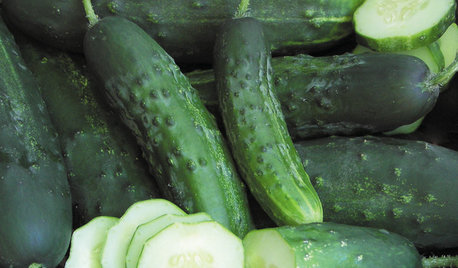Succession Planting/Crop Rotation
Wendy Perez/Zone 7a
8 years ago
Featured Answer
Sort by:Oldest
Comments (46)
Related Discussions
Families of plants- crop rotation etc.
Comments (3)There are so many ways to companion plant as you point out. Here are three groupings I look at: (1) botanical, (2) feeding groups, and (3) "better-togehter". I rotate through the beds using the final (3)"better-together" groupings with some seasonal variations for weather. 1. Botanical families (similar cultural needs and pest problems): * Aster family: chicory, endive, lettuce, sunflowers--usually in cool weather or shade in summer. * Cabbage family: broccoli, brussels sprouts, cabbage, collards, kale, radishes, turnips-- heavy feeders. * Carrot family: carrot, celery, dill, fennel, parsley--coole weather, but some like heat. * Corn (grass family): heavy feeder, lots of water. * Legumes: beans, peas: nitrogen fixers. * Onion family: asparagus, chives, garlic, leeks, onions: light feeders, onion maggots. * Beets and spinach and chard: coole weather. * Squash family: cucumbers, melons, pumpkins, squahs: warm weather, common insects and disease problems. * Tomatoes and friends: eggplant, peppers, potatoes: heat-lovers, similar soil. 2. Feeding groups (similar soil and nutrition needs): * Heavy feeders: celery, corn, cucumbers, eggplant, melons, peppers, pumpkins, squash, tomaotes. * Moderate feeders: broccoli, brussels sprouts, cabbage, cauliflower, chard, Chinese cabbage, kale, lettuce and greens, parsley, spinach. * Light feeders: beets, carrots, garlic, leeks, onions, potaotes, radishes, turnips. * Soil builders: beans, peas. 3. Better-together groups (anecdotal helpmates): * Potatoes and beans planted together with calendulas, cosmos, daisies, dill, rosemany. Three-year rotation. * Squash family members, corn, and pole beans planted together with borage, dill, nasturtiums, sunflowers. Three-year rotation. * Tomato and warm-fruiters, peppers, eggplants planted with basil, cosmos, parsley, Queen-Anne's-lace. Four-year rotation. * Cabbage family, lettuce and root crops planted together with asters, calendulas, chamomile, chrysanthemums, cosmos, marigolds, rosemary, sage, thyme. Three-year rotation. * Roots and greens--carrots, onions, greens planted with caraway, chamomile, dill, fennel, Iceland poppies, asters. Two-year rotation. * Perennial crops--asparagus, horseradish, strawberries, rhubarb surrounded by borage, sweet alyssum, chives, bee balm, chamomile, thyme, tansy, yarrow, cosmos, dill. Here is a link that might be useful: HarvestToTable.com...See Morecrop rotation
Comments (2)He does and if I understand your question you are asking what plant should follow the another to best use those nutrients in the soil not taken up by the first planting. I'll need to refresh my memory but I do recall ... heavy feeders first than I think its light feeders followed by nitrogen fixers (legumes). And if possible a rest period than the cycle restarts. Of course in colder regions without a winter growing season a cover crop for green manure over winter. Again this is from memory and I may have the middle of the cycle askew. Mike...See MoreRotating Crops
Comments (4)I'm growing some 60 day early glo corn. I'm doing square foot style but my beds are a 3 foot wide bed that wraps the perimeter of my yard. My corn bed is 3 feet by about 20ish long but easily could have been 10. It's doing very well right now, but I won't know how well it has pollinated until I pull ears. They're just starting to fill out. Should be ready in about 2 weeks or so. I planted pretty close and have fertilized them every week with 10 10 10. Also given them lots of water. My theory is since corns a grass it grows best with a lot of water. This early glo is about 4 or 5 feet tall, so my theory was it might tolerate the tight growing conditions of square foot. I'll let you know how it goes, but I was a bit late getting it planted so I'm hoping the weather doesn't zap us before they mature. One weird thing is there are little short plants here and there, espeially at the two ends of the rows. I wouldn't think it would have anything to do with pollination. And if it were going to be stunted, why wouldn't it all be stunted. I'm a little suspicious of my seed as it was a pack of seed I had bought a couple of years ago and never got around to trying....See MoreRotate tomatoe crops???
Comments (9)I'm wondering about this too. I have a small garden and only 6 hrs of sun in the prime location where my tomatoes always go. I had my beds on a N/S axis and so the tomatoes would go in the north end of the beds. I would try to rotate them to the south end, but then they shade the rest of the garden. We're about to build new beds and I'm planning some beds on the N/S axis and some on the E/W axis. That way I will grow beans and peas on the N/S axis and the tomatoes on the E/W and I can at least change beds back and forth. I could move the tomatoes to the East side of the plot too, but then I am getting into shade issues again. But maybe that will work ok in that third year when the tomatoes are on the East side of the plot, and the other two years, they should be great. That's an improvement over what I've had at least....See MoreWendy Perez/Zone 7a
8 years agoWendy Perez/Zone 7a
8 years agoWendy Perez/Zone 7a
8 years agoWendy Perez/Zone 7a
8 years agorgreen48
8 years agoWendy Perez/Zone 7a
8 years agoWendy Perez/Zone 7a
8 years agoLoneJack Zn 6a, KC
8 years agolast modified: 8 years agoWendy Perez/Zone 7a thanked LoneJack Zn 6a, KCWendy Perez/Zone 7a
8 years agoWendy Perez/Zone 7a
8 years agolast modified: 8 years agoLoneJack Zn 6a, KC
8 years agoWendy Perez/Zone 7a
8 years agonewgardener
8 years agolast modified: 8 years agorgreen48
8 years agolast modified: 8 years agodigdirt2
8 years agoPeter (6b SE NY)
8 years agolast modified: 8 years agofbx22
8 years agolast modified: 8 years agonewgardener
8 years agoHumsi
8 years agolast modified: 8 years agorgreen48
8 years agolast modified: 8 years agonewgardener
8 years agoSwety Bear (Central MS ZONE 8)
6 years agolast modified: 6 years agodigdirt2
6 years agoWendy Perez/Zone 7a
6 years agoSwety Bear (Central MS ZONE 8)
6 years agoWendy Perez/Zone 7a
6 years agodaninthedirt (USDA 9a, HZ9, CentTX, Sunset z30, Cfa)
6 years agolast modified: 6 years agodigdirt2
6 years agoWendy Perez/Zone 7a
6 years agolast modified: 6 years agoLoneJack Zn 6a, KC
6 years agoWendy Perez/Zone 7a
6 years agoWendy Perez/Zone 7a
6 years agotheforgottenone1013 (SE MI zone 5b/6a)
6 years agolast modified: 6 years agorgreen48
6 years agolast modified: 6 years ago
Related Stories

GARDENING GUIDESOrganic Matters: Thwart Insect Pests With Trap Crops
Add a few sacrificial plants to your garden to lure insects away from the harvest
Full Story
GARDENING AND LANDSCAPINGCream-of-the-Crop Vegetable Gardens
Both trendy and traditional, these inspired potager designs turn the everyday vegetable garden into art for your landscape
Full Story
SUMMER FRUITS AND VEGETABLESHow to Grow Your Own Fresh, Sweet Corn
Here's how to plant and care for your own mini cornfield
Full Story
EDIBLE GARDENSSummer Crops: How to Grow Tomatoes
Plant tomato seedlings in spring for one of the best tastes of summer, fresh from your backyard
Full Story
EDIBLE GARDENSSummer Crops: How to Grow Squash
Almost foolproof and with cheerful flowers, squash comes in a wide range of varieties to plant in spring
Full Story
EDIBLE GARDENSSummer Crop: How to Grow Blueberries
Plant blueberries in spring or fall for garden beauty through three seasons — and a sweet superfood in summer
Full Story
EDIBLE GARDENSHow to Grow Your Own Sweet Summer Crops
This guide will help any gardener get started on growing the freshest warm-season veggies and berries for summer
Full Story
SPRING GARDENINGSummer Crops: How to Grow Strawberries
Pluck your own sweet strawberries right from the garden vine for smoothies, salads or eating then and there
Full Story
SUMMER FRUITS AND VEGETABLESSummer Crops: How to Grow Cucumbers
Pick a peck for pickles or opt for fewer and raw — no matter how you slice them, cucumbers are great for summer gardens small to large
Full Story
GARDENING GUIDESSummer Crops: How to Grow Peppers
Some like 'em hot; others like them sweet. With the incredible range of peppers available for home gardens, you can have your pick
Full StorySponsored
Columbus Area's Luxury Design Build Firm | 17x Best of Houzz Winner!




beesneeds